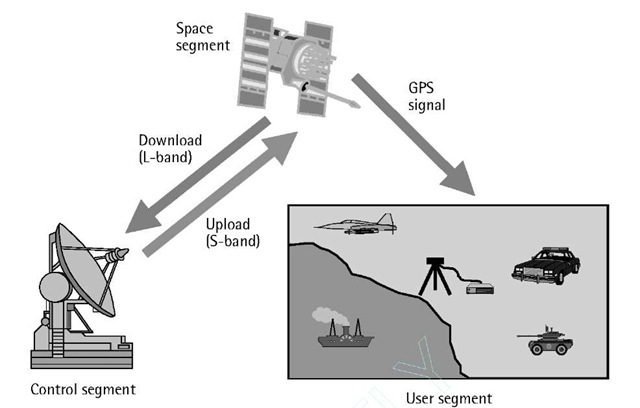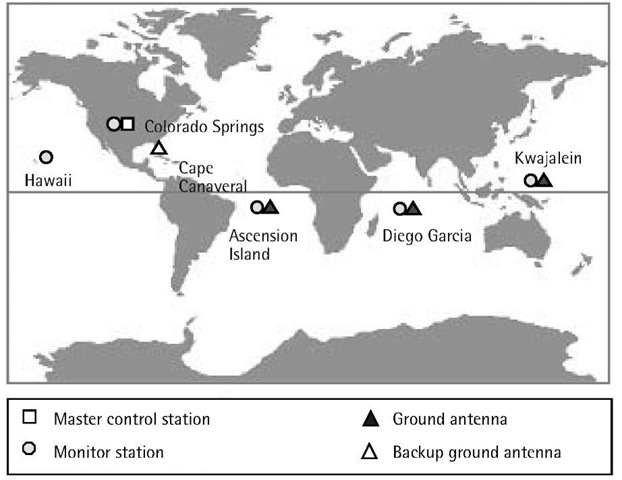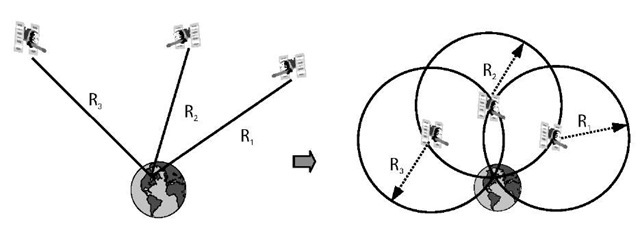The Global Positioning System (GPS) is a satellite-based navigation system that was developed by the U.S. Department of Defense (DoD) in the early 1970s. Initially, GPS was developed as a military system to fulfill U.S. military needs. However, it was later made available to civilians, and is now a dual-use system that can be accessed by both military and civilian users [1].
GPS provides continuous positioning and timing information, anywhere in the world under any weather conditions. Because it serves an unlimited number of users as well as being used for security reasons, GPS is a one-way-ranging (passive) system [2]. That is, users can only receive the satellite signals. This topic introduces the GPS system, its components, and its basic idea.
Overview of GPS
GPS consists, nominally, of a constellation of 24 operational satellites. This constellation, known as the initial operational capability (IOC), was completed in July 1993. The official IOC announcement, however, was made on December 8, 1993 [3]. To ensure continuous worldwide coverage, GPS satellites are arranged so that four satellites are placed in each of six orbital planes (Figure 1.1). With this constellation geometry, four to ten GPS satellites will be visible anywhere in the world, if an elevation angle of 10° is considered. As discussed later, only four satellites are needed to provide the positioning, or location, information.
GPS satellite orbits are nearly circular (an elliptical shape with a maximum eccentricity is about 0.01), with an inclination of about 55° to the equator. The semimajor axis of a GPS orbit is about 26,560 km (i.e., the satellite altitude of about 20,200 km above the Earth’s surface) [4]. The corresponding GPS orbital period is about 12 sidereal hours (~11 hours, 58 minutes). The GPS system was officially declared to have achieved full operational capability (FOC) on July 17, 1995, ensuring the availability of at least 24 operational, nonexperimental, GPS satellites. In fact, as shown in Section 1.4, since GPS achieved its FOC, the number of satellites in the GPS constellation has always been more than 24 operational satellites.
GPS segments
GPS consists of three segments: the space segment, the control segment, and the user segment (Figure 1.2) [5]. The space segment consists of the 24-satellite constellation introduced in the previous section. Each GPS satellite transmits a signal, which has a number of components: two sine waves (also known as carrier frequencies), two digital codes, and a navigation message. The codes and the navigation message are added to the carriers as binary biphase modulations [5]. The carriers and the codes are used mainly to determine the distance from the user’s receiver to the GPS satellites.
Figure 1.1 GPS constellation.
Figure 1.2 GPS segments.
The navigation message contains, along with other information, the coordinates (the location) of the satellites as a function of time. The transmitted signals are controlled by highly accurate atomic clocks onboard the satellites.
The control segment of the GPS system consists of a worldwide network of tracking stations, with a master control station (MCS) located in the United States at Colorado Springs, Colorado. The primary task of the operational control segment is tracking the GPS satellites in order to determine and predict satellite locations, system integrity, behavior of the satellite atomic clocks, atmospheric data, the satellite almanac, and other considerations. This information is then packed and uploaded into the GPS satellites through the S-band link.
The user segment includes all military and civilian users. With a GPS receiver connected to a GPS antenna, a user can receive the GPS signals, which can be used to determine his or her position anywhere in the world. GPS is currently available to all users worldwide at no direct charge.
GPS satellite generations
GPS satellite constellation buildup started with a series of 11 satellites known as Block I satellites (Figure 1.3). The first satellite in this series (and in the GPS system) was launched on February 22, 1978; the last was launched on October 9,1985. Block I satellites were built mainly for experimental purposes. The inclination angle of the orbital planes of these satellites, with respect to the equator, was 63°, which was modified in the following satellite generations [6]. Although the design lifetime of Block I satellites was 4.5 years, some remained in service for more than 10 years. The last Block I satellite was taken out of service on November 18, 1995.
The second generation of the GPS satellites is known as Block II/IIA satellites (Figure 1.3). Block IIA is an advanced version of Block II, with an increase in the navigation message data storage capability from 14 days for Block II to 180 days for Block IIA. This means that Block II and Block IIA satellites can function continuously, without ground support, for periods of 14 and 180 days, respectively. A total of 28 Block II/IIA satellites were launched during the period from February 1989 to November 1997. Of these, 23 are currently in service. Unlike Block I, the orbital plane of Block II/IIA satellites are inclined by 55° with respect to the equator. The design lifetime of a Block II/IIA satellite is 7.5 years, which was exceeded by most Block II/IIA satellites. To ensure national security, some security features, known as selective availability (SA) and antispoofing, were added to Block II/IIA satellites [3, 6].
A new generation of GPS satellites, known as Block IIR, is currently being launched (Figure 1.3). These replenishment satellites will be backward compatible with Block II/IIA, which means that the changes are transparent to the users. Block IIR consists of 21 satellites with a design life of 10 years. In addition to the expected higher accuracy, Block IIR satellites have the capability of operating autonomously for at least 180 days without ground corrections or accuracy degradation. The autonomous navigation capability of this satellite generation is achieved in part through mutual satellite ranging capabilities. In addition, predicted ephemeris and clock data for a period of 210 days are uploaded by the ground control segment to support the autonomous navigation. More features will be added to the last 12 Block IIR satellites under the GPS modernization program, which will be launched at the beginning of2003 [7]. As of July 2001, six Block IIR satellites have been successfully launched.
Figure 1.3 GPS satellite generations.
Block IIR will be followed by another system, called Block IIF (for "follow-on"), consisting of 33 satellites. The satellite life span will be 15 years. Block IIF satellites will have new capabilities under the GPS modernization program that will dramatically improve the autonomous GPS positioning accuracy.The first Block IIF satellite is scheduled to be launched in 2005 or shortly after that date.
Current GPS satellite constellation
The current GPS constellation (as of July 2001) contains five Block II, 18 Block IIA, and six Block IIR satellites (see Table 1.1). This makes the total number of GPS satellites in the constellation to be 29, which exceeds the nominal 24-satellite constellation by five satellites [8]. All Block I satellites are no longer operational.
The GPS satellites are placed in six orbital planes, which are labeled A through F. Since more satellites are currently available than the nominal 24-satellite constellation, an orbital plane may contain four or five satellites. As shown in Table 1.1, all of the orbital planes have five satellites, except for orbital plane C, which has only four. The satellites can be identified by various systems. The most popular identification systems within the GPS user community are the space vehicle number (SVN) and the pseudorandom noise (PRN); the PRN number will be defined later. Block II/IIA satellites are equipped with four onboard atomic clocks: two cesium (Cs) and two rubidium (Rb). The cesium clock is used as the primary timing source to control the GPS signal. Block IIR satellites, however, use rubidium clocks only.
Table 1.1 GPS Satellite Constellation as of July 2001
|
Sequence |
SVN |
PRN |
Orbital Plane |
Clock |
Sequence |
SVN |
PRN |
Orbital Plane |
Clock |
|
II-2 |
13 |
2 |
B-3 |
Cs |
II-21 |
39 |
9 |
A-1 |
Cs |
|
II-4 |
19 |
19 |
A-5 |
Cs |
II-22 |
35 |
5 |
B-4 |
Cs |
|
II-5 |
17 |
17 |
D-3 |
Cs |
II-23 |
34 |
4 |
D-4 |
Rb |
|
II-8 |
21 |
21 |
E-2 |
Cs |
II-24 |
36 |
6 |
C-1 |
Cs |
|
II-9 |
15 |
15 |
D-5 |
Cs |
II-25 |
33 |
3 |
C-2 |
Cs |
|
II-10 |
23 |
23 |
E-5 |
Cs |
II-26 |
40 |
10 |
E-3 |
Cs |
|
II-11 |
24 |
24 |
D-1 |
Cs |
II-27 |
30 |
30 |
B-2 |
Cs |
|
II-12 |
25 |
25 |
A-2 |
Cs |
II-28 |
38 |
8 |
A-3 |
Rb |
|
II-14 |
26 |
26 |
F-2 |
Rb |
IIR-2 |
43 |
13 |
F-3 |
Rb |
|
II-15 |
27 |
27 |
A-4 |
Cs |
IIR-3 |
46 |
11 |
D-2 |
Rb |
|
II-16 |
32 |
1 |
F-4 |
Cs |
IIR-4 |
51 |
20 |
E-1 |
Rb |
|
II-17 |
29 |
29 |
F-5 |
Rb |
IIR-5 |
44 |
28 |
B-5 |
Rb |
|
II-18 |
22 |
22 |
B-1 |
Rb |
IIR-6 |
41 |
14 |
F-1 |
Rb |
|
II-19 |
31 |
31 |
C-3 |
Cs |
IIR-7 |
54 |
18 |
E-4 |
Rb |
|
II-20 |
37 |
7 |
C-4 |
Rb |
It should be pointed out that two satellites, PRN05 and PRN06, are equipped with corner cube reflectors to be tracked by laser ranging (Table 1.1).
Control sites
The control segment of GPS consists of a master control station (MCS), a worldwide network of monitor stations, and ground control stations (Figure 1.4). The MCS, located near Colorado Springs, Colorado, is the central processing facility of the control segment and is manned at all times [9].
There are five monitor stations, located in Colorado Springs (with the MCS), Hawaii, Kwajalein, Diego Garcia, and Ascension Island. The positions (or coordinates) of these monitor stations are known very precisely.
Figure 1.4 GPS control sites.
Each monitor station is equipped with high-quality GPS receivers and a cesium oscillator for the purpose of continuous tracking of all the GPS satellites in view. Three of the monitor stations (Kwajalein, Diego Garcia, and Ascension Island) are also equipped with ground antennas for uploading the information to the GPS satellites. All of the monitor stations and the ground control stations are unmanned and operated remotely from the MCS.
The GPS observations collected at the monitor stations are transmitted to the MCS for processing. The outcome of the processing is predicted satellite navigation data that includes, along with other information, the satellite positions as a function of time, the satellite clock parameters, atmospheric data, satellite almanac, and others. This fresh navigation data is sent to one of the ground control stations to upload it to the GPS satellites through the S-band link.
Monitoring the GPS system integrity is also one of the tasks of the MCS. The status of a satellite is set to unhealthy condition by the MCS during satellite maintenance or outages. This satellite health condition appears as a part of the satellite navigation message on a near real-time basis. Scheduled satellite maintenance or outage is reported in a message called Notice Advisory to Navstar Users (NANU), which is available to the public through, for example, the U.S. Coast Guard Navigation Center [8].
GPS: The basic idea
The idea behind GPS is rather simple. If the distances from a point on the Earth (a GPS receiver) to three GPS satellites are known along with the satellite locations, then the location of the point (or receiver) can be determined by simply applying the well-known concept of resection [10]. That is all! But how can we get the distances to the satellites as well as the satellite locations?
As mentioned before, each GPS satellite continuously transmits a microwave radio signal composed oftwo carriers, two codes, and a navigation message. When a GPS receiver is switched on, it will pick up the GPS signal through the receiver antenna. Once the receiver acquires the GPS signal, it will process it using its built-in software. The partial outcome of the signal processing consists of the distances to the GPS satellites through the digital codes (known as the pseudoranges) and the satellite coordinates through the navigation message.
Theoretically, only three distances to three simultaneously tracked satellites are needed. In this case, the receiver would be located at the intersection of three spheres; each has a radius of one receiver-satellite distance and is centered on that particular satellite (Figure 1.5). From the practical point of view, however, a fourth satellite is needed to account for the receiver clock offset [6].
The accuracy obtained with the method described earlier was until recently limited to 100m for the horizontal component, 156m for the vertical component, and 340 ns for the time component, all at the 95% probability level. This low accuracy level was due to the effect of the so-called selective availability, a technique used to intentionally degrade the autonomous real-time positioning accuracy to unauthorized users [3]. With the recent presidential decision of terminating the selective availability, the obtained horizontal accuracy is expected to improve to about 22m (95% probability level) [7, 11].
Figure 1.5 Basic idea of GPS positioning.
To further improve the GPS positioning accuracy, the so-called differential method, which employs two receivers simultaneously tracking the same GPS satellites, is used. In this case, positioning accuracy level of the order of a subcentimeter to a few meters can be obtained.
Other uses of GPS include the determination of the user’s velocity, which could be determined by several methods. The most widely used method is based on estimating the Doppler frequency of the received GPS signal [6]. It is known that the Doppler shift occurs as a result of the relative satellite-receiver motion. GPS may also be used in determining the attitude of a rigid body, such as an aircraft or a marine vessel. The word "attitude" means the orientation, or the direction, of the rigid body, which can be described by the three rotation angles of the three axes of the rigid body with respect to a reference system. Attitude is determined by equipping the body with a minimum of three GPS receivers (or one special receiver) connected to three antennas, which are arranged in a nonstraight line [12]. Data collected at the receivers are then processed to obtain the attitude of the rigid body.
GPS positioning service
As stated earlier, GPS was originally developed as a military system, but was later made available to civilians as well. However, to keep the military advantage, the U.S. DoD provides two levels of GPS positioning and timing services: the Precise Positioning Service (PPS) and the Standard Positioning Service (SPS) [3].
PPS is the most precise autonomous positioning and timing service. It uses one of the transmitted GPS codes, known as P(Y)-code, which is accessible by authorized users only. These users include U.S. military forces. The expected positioning accuracy provided by the PPS is 16m for the horizontal component and 23m for the vertical component (95% probability level).
SPS, however, is less precise than PPS. It uses the second transmitted GPS code, known as the C/A-code, which is available free of charge to all users worldwide, authorized and unauthorized. Originally, SPS provided positioning accuracy of the order of 100m for the horizontal component and 156m for the vertical component (95% probability level). This was achieved under the effect of selective availability. With the recent presidential decision of discontinuing the SA, the SPS autonomous positioning accuracy is presently at a comparable level to that of the PPS.
Why use GPS?
GPS has revolutionized the surveying and navigation fields since its early stages of development. Although GPS was originally designed as a military system, its civil applications have grown much faster. As for the future, it is said that the number of GPS applications will be limited only to one’s imagination.
On the surveying side, GPS has replaced the conventional methods in many applications. GPS positioning has been found to be a cost-effective process, in which at least 50% cost reduction can be obtained whenever it is possible to use the so-called real-time kinematic (RTK) GPS, as compared with conventional techniques [13]. In terms of productivity and time saving, GPS could provide more than 75% timesaving whenever it is possible to use the RTK GPS method .The fact that GPS does not require intervisibility between stations has also made it more attractive to surveyors over the conventional methods. For those situations in which the GPS signal is obstructed, such as in urban canyons, GPS has been successfully integrated with other conventional equipment.
GPS has numerous applications in land, marine, and air navigation. Vehicle tracking and navigation are rapidly growing applications. It is expected that the majority of GPS users will be in vehicle navigation.
Future uses of GPS will include automatic machine guidance and control, where hazardous areas can be mapped efficiently and safely using remotely controlled vehicles. The recent U.S. decision to modernize GPS and to terminate the selective availability will undoubtedly open the door for a number of other applications yet to be developed [10].





